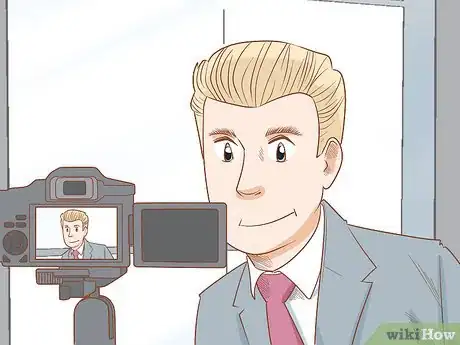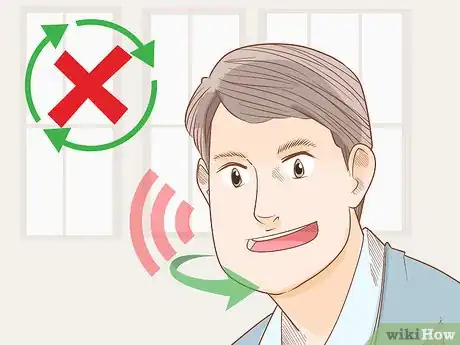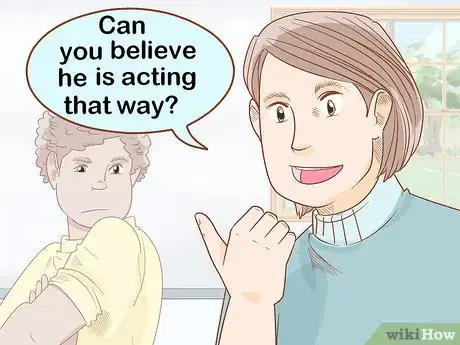This article was co-authored by Murisa Harba. Murisa Harba is an Acting Coach, Dance Instructor, and the Artistic Director & Owner of About the Works Actors Studio and Take My Lead LA. With over 13 years of experience, she specializes in private ballroom dancing lessons and encouraging actors to creatively tell stories. Murisa holds a BFA in Theatre and a Minor in Dance from Boston University’s College of Fine Arts.
This article has been viewed 35,527 times.
When an actor directly engages the audience, that is known as “breaking the fourth wall.” It's a great way to further develop the plot or add some extra emotions to the show, and is effective in both comedies and dramas. You can master the technique by practicing speaking directly to the audience (or camera) and utilizing other tools to convey your message. Have fun finding the motivation that works for your character!
Steps
Engaging the Audience
-
1Face the audience or the camera. When the moment in the script calls for you to speak to the audience, you will most likely want to look directly at them. Turn and look straight at the audience or the camera. You can either turn your entire body to do this, or just turn your head.[1]
- It's usually best to only break the fourth wall when the script explicitly calls for it.
- Practice doing this during rehearsal so that you will feel comfortable.
-
2Speak directly to the audience for the most straightforward approach. While in character, look at the audience and give them your message. This is the simplest, most effective way to tell them what you want them to know.
- For example, maybe your character is fighting with another character. You might break the scene by turning to the audience and saying, “Jill doesn't know that this fight isn't really about the money she borrowed. It's about her lies.”
- The movie Ferris Bueller's Day Off effectively used this technique when the title character spoke directly to the camera.
Advertisement -
3Break character if you need to comment on emotions. You might at times want to speak to the audience as yourself to comment on your character. This is also known as “third person narration.”[2]
- If you are playing a character named Scott, you might look at the camera or audience and say, “Scott wasn't used to being ignored, and it was making him feel an anger he'd never felt before.”
- This is most effective if the plot doesn't clearly explain emotions to the audience.
-
4Use facial expressions to convey emotions. You don't always have to use words to get your message across. Facial expressions are really useful, too. If 2 characters are having a ridiculous fight, you might look at the audience and either roll your eyes or raise your eyebrows.
- A great example of this technique is the character of Jim in the show The Office, who does this frequently.
- You can make this really subtle, too, with just a small smile or wink aimed at the audience.
-
5Utilize placards to let the audience in on a secret. Placards, or signs, are a great way to silently convey your message. There might be information that the audience needs to know, but it's not easy to find a spot for it in the script. You can let the audience in on the secret by giving them a written message.[3]
- You could hold a placard reading “Julie is pregnant, but doesn't yet know it,” while facing the audience.
- Work with the director to figure out where to put the placard when you're not using it. Maybe someone hands it to you from offstage, or you keep it hidden behind a piece of scenery.
-
6Avoid overusing this technique. You might get a lot of gasps or laughs when you break the fourth wall, and that will obviously feel good! However, you want to make sure to use the technique sparingly so that the audience doesn't grow bored of it. It depends on what type of performance you are doing, but you probably don't need to break the fourth wall in every scene.
- You also want the audience to engage with the material. If you break the fourth wall too frequently, they might just rely on how you tell them to feel, rather than experiencing their own emotions.
Finding the Right Motivation
-
1Use direct address to explain the plot. There are many reasons you might need to break the fourth wall. One of the most common is to explain the plot to the audience. This will help them to understand any information that is not clear from the script. [4]
- Look directly to the audience and explain what you need to. For example, “What Scott doesn't know is that Tara is actually his twin, and they were separated at birth.”
-
2Speak to the audience to gain sympathy for a character. Sometimes it is helpful for the audience to know why a character is acting a certain way. You might want them to feel sympathetic towards a character, so try breaking the fourth wall to let them know how to feel.[5]
- For example, “Don't get too mad at Tara. She didn't actually forget Scott's birthday. She's planning a major surprise!”
-
3Break the fourth wall to make the audience feel engaged. This is a great technique to make the audience feel like they're really part of the action. You can use this technique with a live audience, or for a TV show or movie. You might say something like, “Wow, what a party! Wouldn't you like to be there?” [6]
- You could also try something like, “Can you believe he is acting that way? I don't know about you, but I'd be nicer to my boss.”
- You want to engage them and get them at the edge of their seats, waiting to see what's going to happen.
- If the audience is already engaged, you probably don't need to break the fourth wall. For example, it's probably unnecessary in a scene that is already emotionally charged.
Expert Q&A
-
QuestionIs breaking the 4th wall good?
 Murisa HarbaMurisa Harba is an Acting Coach, Dance Instructor, and the Artistic Director & Owner of About the Works Actors Studio and Take My Lead LA. With over 13 years of experience, she specializes in private ballroom dancing lessons and encouraging actors to creatively tell stories. Murisa holds a BFA in Theatre and a Minor in Dance from Boston University’s College of Fine Arts.
Murisa HarbaMurisa Harba is an Acting Coach, Dance Instructor, and the Artistic Director & Owner of About the Works Actors Studio and Take My Lead LA. With over 13 years of experience, she specializes in private ballroom dancing lessons and encouraging actors to creatively tell stories. Murisa holds a BFA in Theatre and a Minor in Dance from Boston University’s College of Fine Arts.
Acting Coach & Dance Instructor It can be—it really depends on the creative vision of the project. For instance, a monologue in a Shakespeare play might break the fourth wall to incorporate the audience into the project. Breaking the fourth wall can also happen in film and on TV, but it's always very specific to the tone and style of the show.
It can be—it really depends on the creative vision of the project. For instance, a monologue in a Shakespeare play might break the fourth wall to incorporate the audience into the project. Breaking the fourth wall can also happen in film and on TV, but it's always very specific to the tone and style of the show. -
QuestionHow do you engage an audience when performing?
 Murisa HarbaMurisa Harba is an Acting Coach, Dance Instructor, and the Artistic Director & Owner of About the Works Actors Studio and Take My Lead LA. With over 13 years of experience, she specializes in private ballroom dancing lessons and encouraging actors to creatively tell stories. Murisa holds a BFA in Theatre and a Minor in Dance from Boston University’s College of Fine Arts.
Murisa HarbaMurisa Harba is an Acting Coach, Dance Instructor, and the Artistic Director & Owner of About the Works Actors Studio and Take My Lead LA. With over 13 years of experience, she specializes in private ballroom dancing lessons and encouraging actors to creatively tell stories. Murisa holds a BFA in Theatre and a Minor in Dance from Boston University’s College of Fine Arts.
Acting Coach & Dance Instructor Think about how you'd like your audience to feel during your performance. You want them to be at the edge of their seat, right? To accomplish this, you need to bring some edge to your performance by finding moments where your character is off-balance and you (as the performer) don't know what's going to happen next. If you aren't sure about what's going to happen, the audience definitely won't, either—and that's exciting.
Think about how you'd like your audience to feel during your performance. You want them to be at the edge of their seat, right? To accomplish this, you need to bring some edge to your performance by finding moments where your character is off-balance and you (as the performer) don't know what's going to happen next. If you aren't sure about what's going to happen, the audience definitely won't, either—and that's exciting. -
QuestionHow many times should you break the fourth wall?There is no "correct" amount of times to break the fourth wall. It depends on the length of the play, what type of play it is and how you break the fourth wall. The technique stops being effective if you overuse it, so use it in moderation. For most of it, show and do not tell, so the audience becomes more engaged. Usually in funnier plays such as pantomimes, breaking the fourth wall is a good technique. Breaking the fourth wall in more emotional plays can ruin the atmosphere. It is also important to note this technique isn't recommended for more realistic dramas. It's up to your own judgement. If you can, get someone to watch it and ask them what they think.
References
- ↑ http://screenprism.com/insights/article/what-does-it-mean-to-break-the-fourth-wall
- ↑ https://www.bbc.com/education/guides/zwmvd2p/revision/4
- ↑ https://www.bbc.com/education/guides/zwmvd2p/revision/4
- ↑ https://theconversation.com/you-talking-to-me-house-of-cards-and-breaking-the-fourth-wall-23919
- ↑ https://theconversation.com/you-talking-to-me-house-of-cards-and-breaking-the-fourth-wall-23919
- ↑ https://theconversation.com/you-talking-to-me-house-of-cards-and-breaking-the-fourth-wall-23919




































































